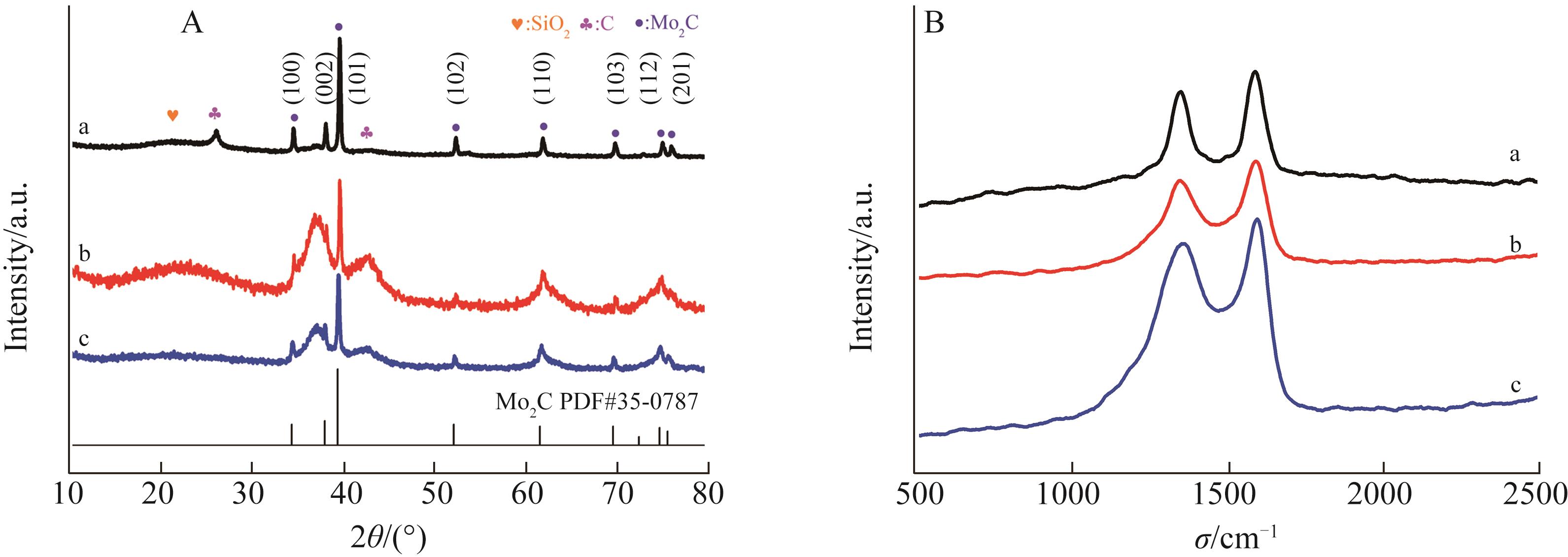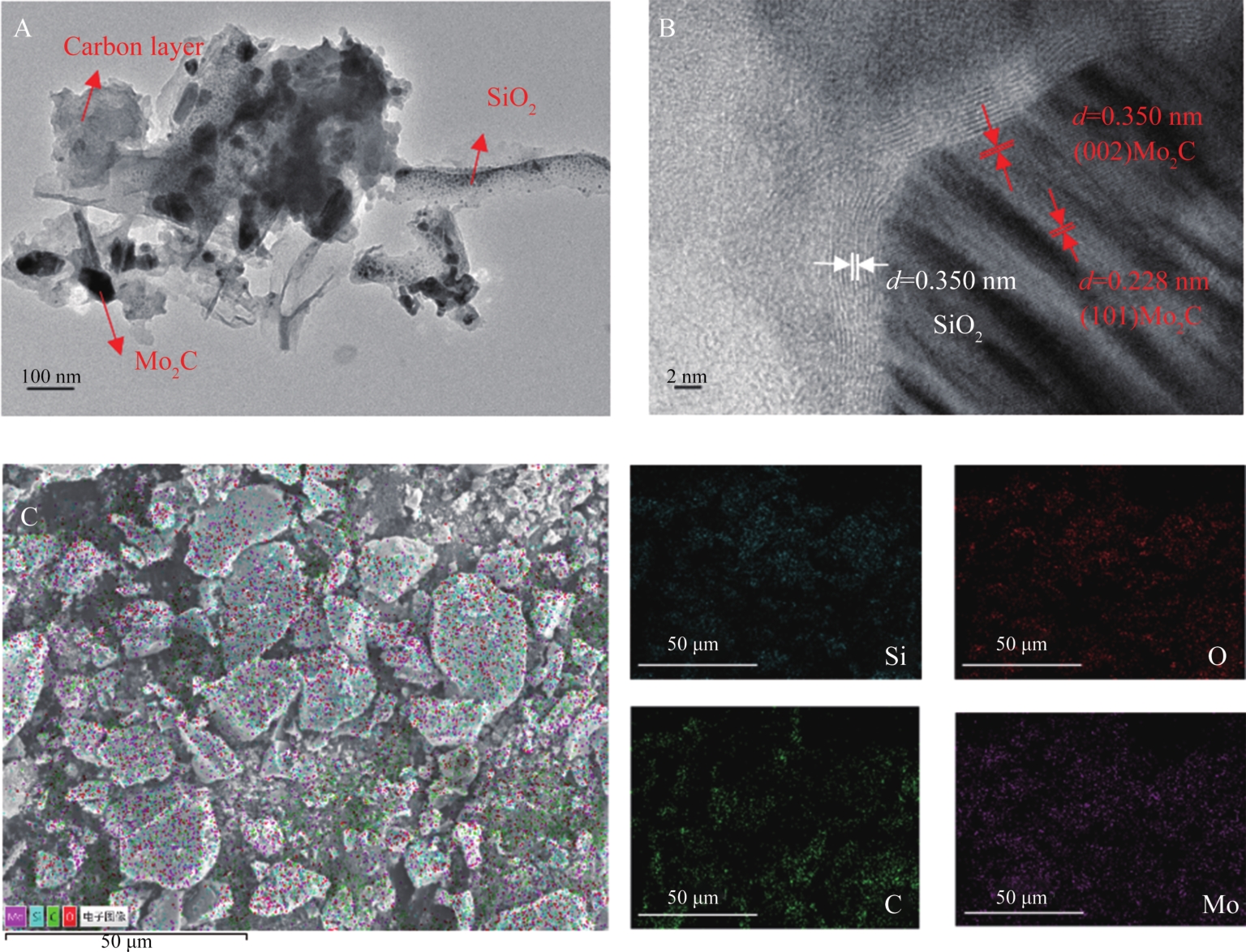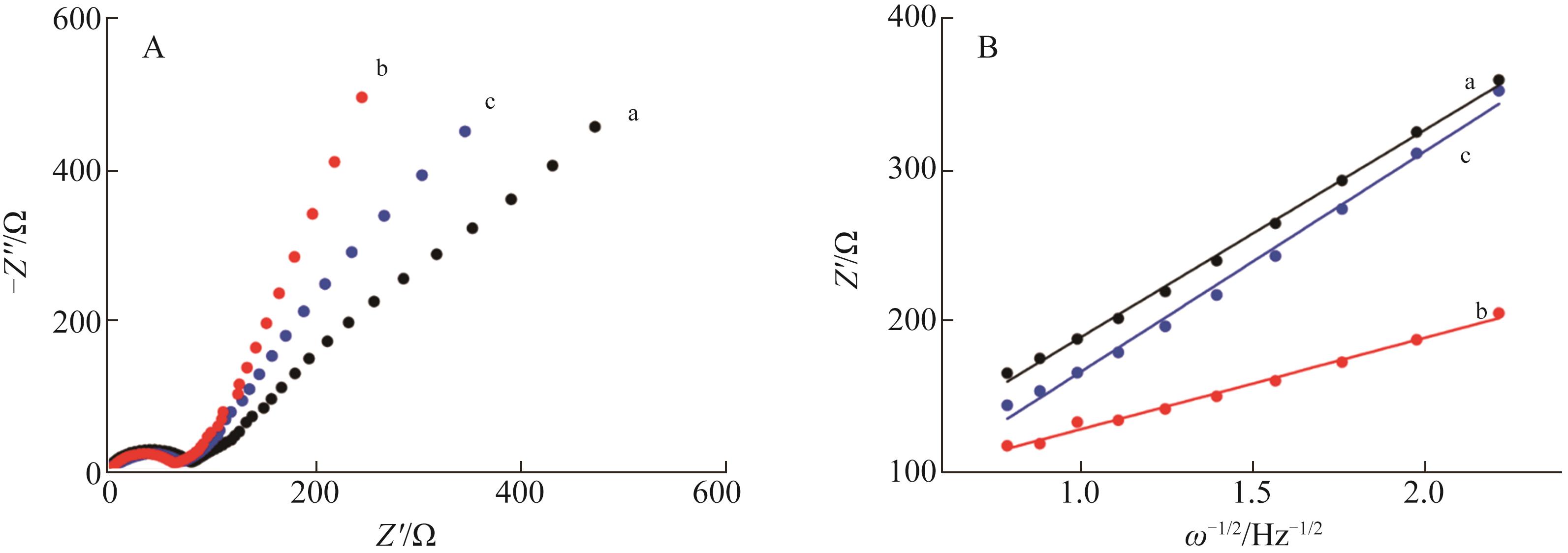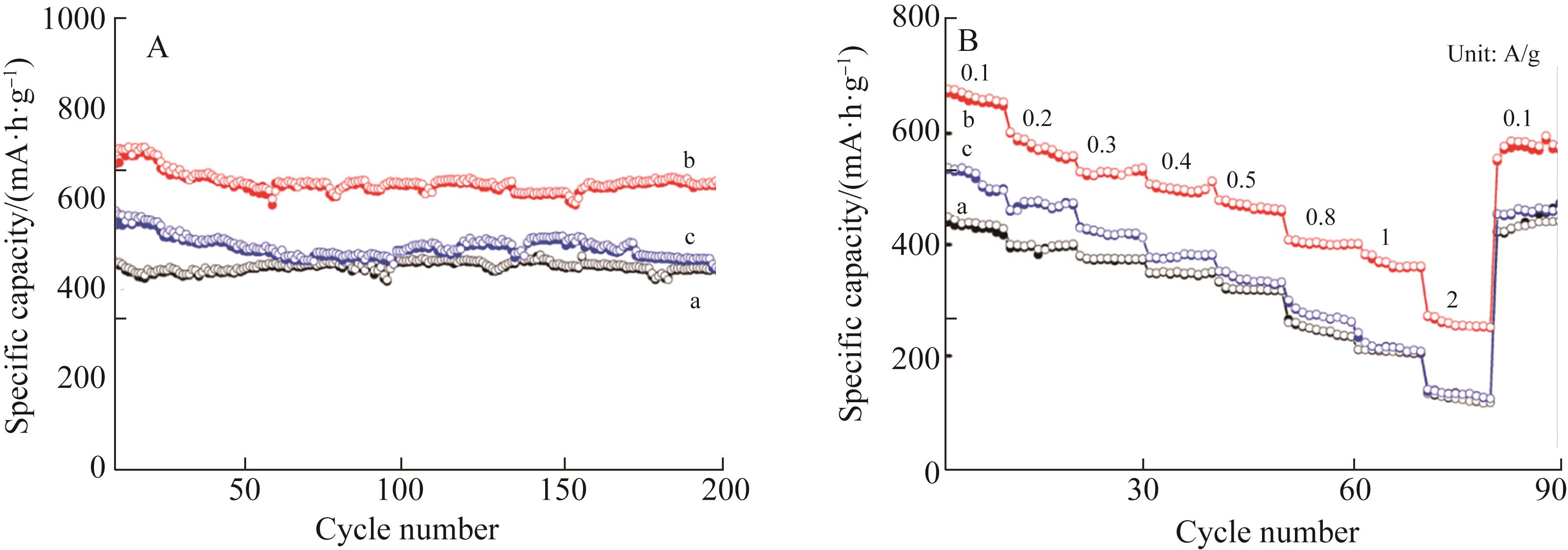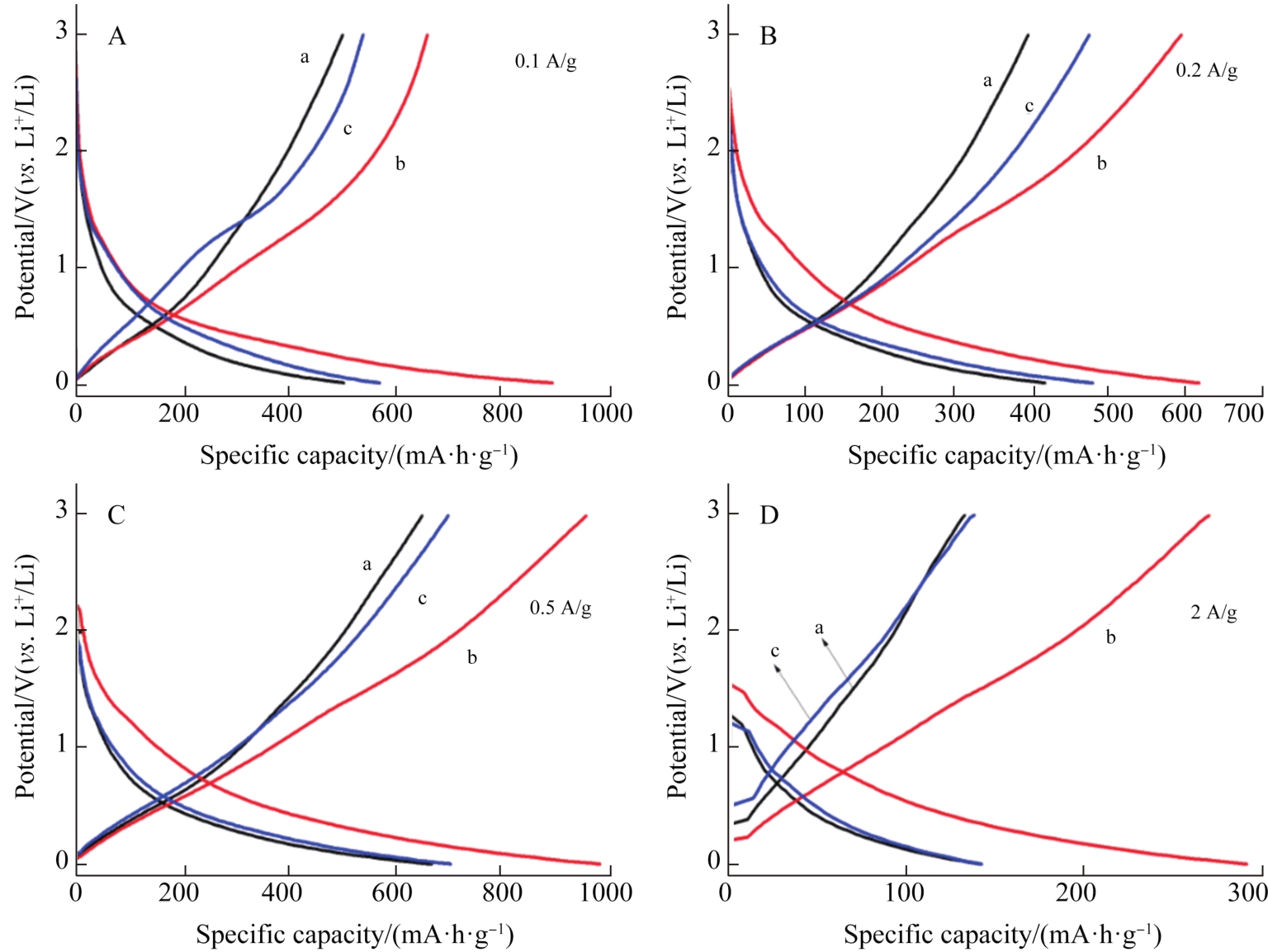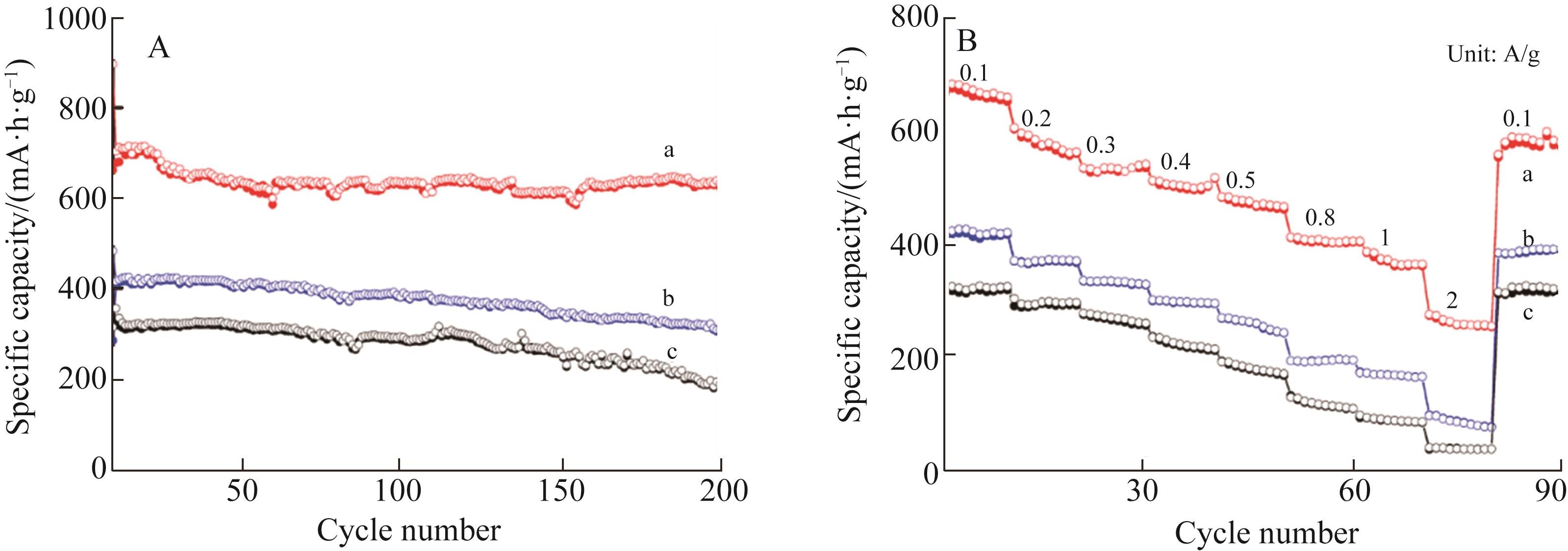
Chinese Journal of Applied Chemistry ›› 2022, Vol. 39 ›› Issue (11): 1716-1725.DOI: 10.19894/j.issn.1000-0518.220039
• Full Papers • Previous Articles Next Articles
Preparation and Electrochemical Properties of Molybdenum Carbide Modified Silica
Yu-Le WANG, Ke-Li YANG, Yan-Fang GAO( )
)
- School of Chemical Engineering,Inner Mongolia University of Technology,Hohhot 010051,China
-
Received:2022-02-18Accepted:2022-05-31Published:2022-11-01Online:2022-11-09 -
Contact:Yan-Fang GAO -
About author:576305770@qq.com
CLC Number:
Cite this article
Yu-Le WANG, Ke-Li YANG, Yan-Fang GAO. Preparation and Electrochemical Properties of Molybdenum Carbide Modified Silica[J]. Chinese Journal of Applied Chemistry, 2022, 39(11): 1716-1725.
share this article
Add to citation manager EndNote|Ris|BibTeX
URL: http://yyhx.ciac.jl.cn/EN/10.19894/j.issn.1000-0518.220039
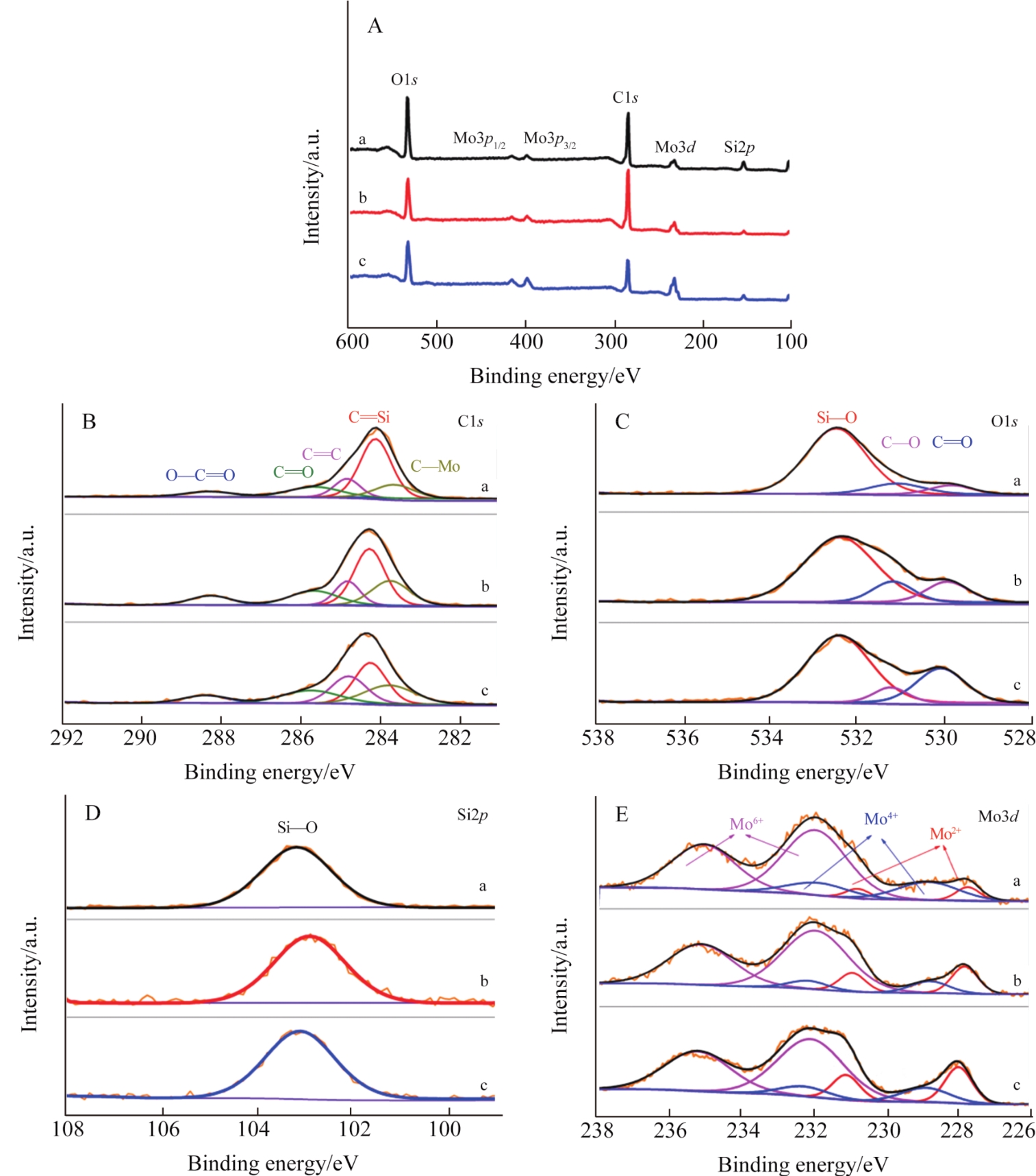
Fig.2 XPS spectra of SiO2/Mo2C/C composites under different material ratios total spectrum (A), C1s spectrum (B), O1s spectrum (C), Si2p spectrum (D) and Mo3d spectrum (E)
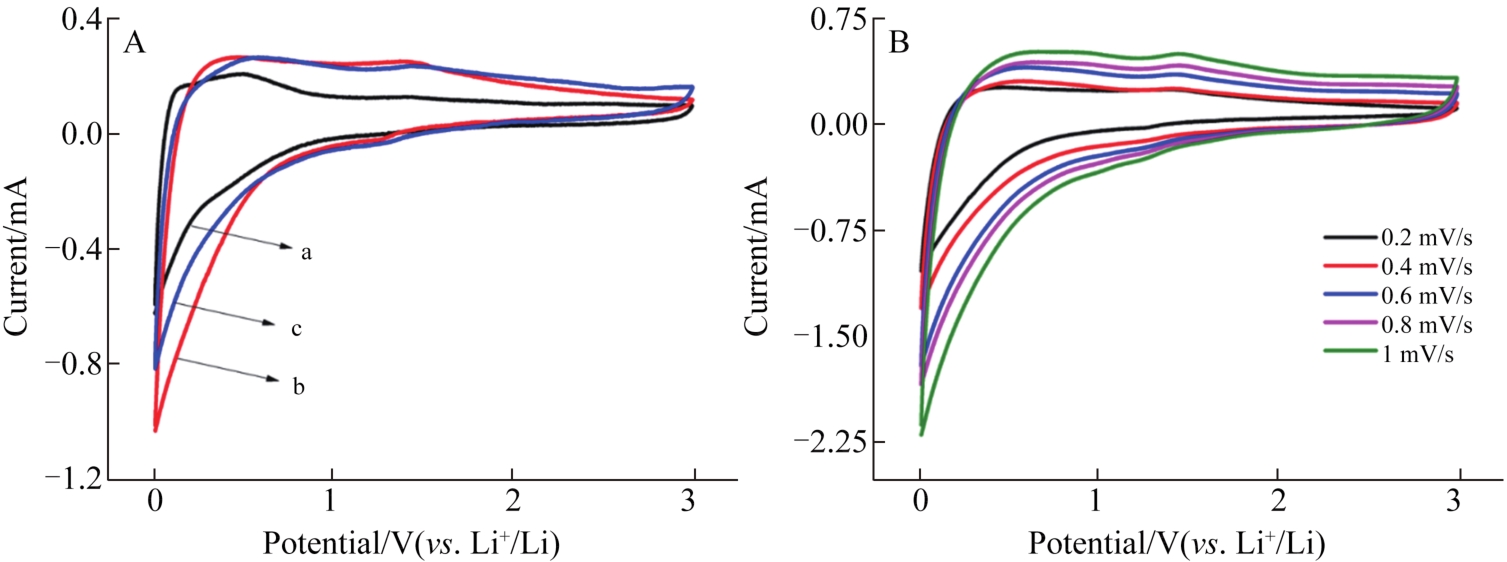
Fig.4 Cyclic voltammograms of SiO2/Mo2C/C composites with different material ratios at a scan speed of 0.2 mV/s (A);Cyclic voltammograms of SiO2/Mo2C/C 2 composites with different scan speed (B)
| 1 | LIANG Y R, ZHAO C Z, YUAN H, et al. A review of rechargeable batteries for portable electronic devices[J]. Infomat, 2019, 1(1): 6-32. |
| 2 | CHENG F Y, LIANG J, TAO Z L, et al. Functional materials for rechargeable batteries[J]. Adv Mater, 2011, 23(15): 1695-1715. |
| 3 | XU C H, XU B H, GU Y, et al. Graphene-based electrodes for electrochemical energy storage[J]. Energy Environ Sci, 2013, 6(5): 1388-1414. |
| 4 | LI G C, YANG Z W, YIN Z L, et al. Non-aqueous dual-carbon lithium-ion capacitors: a review[J]. J Mater Chem A, 2019, 7(26): 15541-15563. |
| 5 | WANG H, WU P, SHI H M, et al. Hollow porous silicon oxide nanobelts for high-performance lithium storage[J]. J Power Sources, 2015, 274: 951-956. |
| 6 | AN W L, FU J J, SU J J, et al. Mesoporous hollow nanospheres consisting of carbon coated silica nanoparticles for robust lithium-ion battery anodes[J]. J Power Sources, 2017, 345: 227-236. |
| 7 | DINH K N, LIANG Q H, DU C F, et al. Nanostructured metallic transition metal carbides, nitrides, phosphides, and borides for energy storage and conversion[J]. Nano Today, 2019, 25: 99-121. |
| 8 | LI J, YANG Q Q, HU Y X, et al. Design of lamellar Mo2C nanosheets assembled by Mo2C nanoparticles as an anode material toward excellent sodium-ion capacitors[J]. ACS Sustainable Chem Eng, 2019, 7(22): 18375-18383. |
| 9 | YANG Z W, WANG H F, CHENG B H, et al. Micronano porous Mo2C@C nanorods composites as robust anodes for Li-ion battery[J]. Energy Technol, 2020, 8(6): 2000189. |
| 10 | XIN H L, HAI Y, LI D Z, et al. Coupling Mo2C@C core-shell nanocrystals on 3D graphene hybrid aerogel for high-performance lithium ion battery[J]. Appl Surf Sci, 2018, 441: 69-76. |
| 11 | YU B, YANG D X, HU Y, et al. Mo2C nanodots anchored on N-doped porous CNT microspheres as electrode for efficient Li-ion storage[J]. Small Methods, 2019, 3(2): 1800287. |
| 12 | XU J G, ZHANG Y, QI J S, et al. Preparation of nanocrystalline MoSi2 with enhanced lithium storage by sol-gel and carbonthermal reduction method[J]. Ceram Int, 2018, 44(8): 9494-9498. |
| 13 | BUGA M R, SPINU-ZAULET A A, UNGUREANU C G, et al. Carbon-coated SiO2 composites as promising anode material for Li-ion batteries[J]. Molecules, 2021, 26(15): 4531. |
| 14 | FENG Y, LIU L, LIU X Y, et al. Enabling the ability of Li storage at high rate as anodes by utilizing natural rice husks-based hierarchically porous SiO2/N-doped carbon composites[J]. Electrochim Acta, 2020, 359: 136933. |
| 15 | LIU X G, LI Z X, ZHANG S H, et al. Mo2C@onion-like carbon/amorphous carbon nanocomposites as outstanding anode materials for ideal lithium-ion batteries[J]. Ceram Int, 2017, 43(16): 14446-14452. |
| 16 | KWAK W J, LAU K C, SHIN C D, et al. A Mo2C/carbon nanotube composite cathode for lithium-oxygen batteries with high energy efficiency and long cycle life[J]. ACS Nano, 2015, 9(4): 4129-4137. |
| 17 | XIAO J, ZHANG Y, ZHANG Z Y, et al. Self-supported biocarbon-fiber electrode decorated with molybdenum carbide nanoparticles for highly active hydrogen-evolution reaction[J]. ACS Appl Mater Interfaces, 2017, 9(27): 22604-22611. |
| 18 | YUE X, CAO M L, WU L M, et al. Rational synthesis of a hierarchical Mo2C/C nanosheet composite with enhanced lithium storage properties[J]. RSC Adv, 2021, 11(41): 25497-25503. |
| 19 | LYU F C, ZENG S S, SUN Z F, et al. Lamellarly stacking porous N, P Co-doped Mo2C/C nanosheets as high performance anode for lithium-ion batteries[J]. Small, 2019, 15(8): 1805022. |
| 20 | WANG L, ZHU X X, TU K K, et al. Synthesis of carbon-SiO2 hybrid layer @ SiO2@CNT coaxial nanotube and its application in lithium storage[J]. Electrochim Acta, 2020, 354: 136726. |
| 21 | WANG H, XU H B, JIA K, et al. ZIF-8-templated hollow cubelike Si/SiO2@C nanocomposites for superior lithium storage performance[J]. ACS Appl Energy Mater, 2019, 2(1): 531-538. |
| 22 | LI H Q, HOU Y H, LI L C. Synthesis of the SiO2@C composites with high-performance electromagnetic wave absorption[J]. Powder Technol, 2019, 343: 129-136. |
| 23 | CHEN Z, XIANG T, XIONG Q M, et al. Highly active SiO2@C nanofiber: high rate and long cycling for lithium ion batteries[J]. Ionics, 2021, 27(4): 1385-1392. |
| 24 | LI R R, WANG S G, WANG W, et al. Ultrafine Mo2C nanoparticles encapsulated in N-doped carbon nanofibers with enhanced lithium storage performance[J]. Phys Chem Chem Phys, 2015, 17(38): 24803-24809. |
| 25 | XIAO Y, ZHENG L R, CAO M H. Hybridization and pore engineering for achieving high-performance lithium storage of carbide as anode material[J]. Nano Energy, 2015, 12: 152-160. |
| 26 | GAO Q, ZHAO X Y, XIAO Y, et al. A mild route to mesoporous Mo2C-C hybrid nanospheres for high performance lithium-ion batteries[J]. Nanoscale, 2014, 6(11): 6151-6157. |
| 27 | WANG B B, WANG G, WANG H. Hybrids of Mo2C nanoparticles anchored on graphene sheets as anode materials for high performance lithium-ion batteries[J]. J Mater Chem A, 2015, 3(33): 17403-17411. |
| 28 | LIAO H X, HOU H S, ZHANG Y, et al. Nano-confined Mo2C particles embedded in a porous carbon matrix: a promising anode for ultra-stable Na storage[J]. Chem Electro Chem, 2017, 4(10): 2669-2676. |
| 29 | MIR R A, PANDEY O P. An ecofriendly route to synthesize C-Mo2C and C/N-Mo2C utilizing waste polyethene for efficient hydrogen evolution reaction (HER) activity and high performance capacitors[J]. Sustainable Energy Fuels, 2020, 4(2): 655-669. |
| 30 | HUSSAIN S, MUHAMMAD S, FAIZAN M, et al. Hierarchical Mo2C@CNT hybrid structure formation for the improved lithium-ion battery storage performance[J]. Nanomaterials, 2021, 11(9): 2195. |
| [1] | Fang-Zheng HU, Xing GAO, Lei LIU, Tian-Heng YUAN, Ning CAO, Kai LI, Ya-Tao WANG, Jian-Hua LI, Hui-Qin LIAN, Xiao-Dong WANG, Xiu-Guo CUI. Advances in Black Phosphorus Anode Advantages and Optimization in Li-ion Battery Anodes [J]. Chinese Journal of Applied Chemistry, 2023, 40(4): 571-582. |
| [2] | Nan-Yu LIN, Feng GAO, Jiang-Ying QU, Jing-Jing TU, Wei-Jun ZHONG, Yun-Hao ZANG. Preparation of Super-hydrophilic/Underwater Oil-phobic High Silicon Cloth and Its Oil-water Separation Performance [J]. Chinese Journal of Applied Chemistry, 2023, 40(3): 449-459. |
| [3] | Qin ZHANG, Wen-Bin LIU, Li-Jiao FAN, Yu-Ming XIE, Guo-Lin HUANG. Research Progress in the Preparation of Functionalized Mesoporous Silica and Its Application in Adsorption and Separation of Uranium from Water [J]. Chinese Journal of Applied Chemistry, 2023, 40(2): 169-187. |
| [4] | Feng LI, Shi-Yu LU, Yu ZHANG, Li-Jun GUO, Xue ZHAI, Cui-Qin LI. Catalytic Properties of Silylated⁃Salicylaldimine Transition Metal Complexes Functionalized Nano⁃silica Catalysts in Ethylene Oligomerization [J]. Chinese Journal of Applied Chemistry, 2022, 39(6): 949-959. |
| [5] | Lin-Hu SONG, Shi-You LI, Jie WANG, Jing-Jing ZHANG, Ning-Shuang ZHANG, Dong-Ni ZHAO, Fei XU. Research Progress of Additives for Acid and Water Removal in Electrolyte of Lithium Ion Battery [J]. Chinese Journal of Applied Chemistry, 2022, 39(5): 697-706. |
| [6] | Jian-Shu XIAO, Yu-Ge WANG, Qian-Qian GU, Zhi-Cai ZHANG, Yong-Peng LYU, Yuan YIN, Hong-Guo SUN, Ya-Fang ZHENG, Zhao-Yan SUN. Formation of Network by Carbon Black, Silica and Their Mixing Fillers in Isoprene Rubber [J]. Chinese Journal of Applied Chemistry, 2022, 39(12): 1833-1841. |
| [7] | Ying ZHAO, Yi-Jia SHAO, Luo-Qian LI, Jian-Wei REN, Shi-Jun LIAO. Research Progress on the Degradation Mechanism and Cycle Stability Improvement of Lithium-Rich Cathode Materials [J]. Chinese Journal of Applied Chemistry, 2022, 39(02): 205-222. |
| [8] | Chun-Mei ZHAO, Xiu-Miao ZHOU, Xi-Xi JIN, Yu-Hang WANG, Yi-Jing DANG. Preparation of Saddle-Shaped Cyclooctatetrathiophene-Based Hybrid Nanomaterials and Fluorescence Properties [J]. Chinese Journal of Applied Chemistry, 2022, 39(02): 283-288. |
| [9] | HU Chen,JIN Yi,ZHU Shaoqing,XU Ye,SHUI Jianglan. Methods for Improving Low-Temperature Performance of Lithium Iron Phosphate Based Li-Ion Battery [J]. Chinese Journal of Applied Chemistry, 2020, 37(4): 380-386. |
| [10] | LIU Lixin, DONG Jianhong, ZHANG Guanghui, ZHU Luyi, WANG Xinqiang, XU Dong, CHOW Yuktak. Preparation and Properties of Polyvinylidene Fluoride@Diatomite Fiber Membranes by Eletrospinning as Separator of Lithium-Ion Batteries [J]. Chinese Journal of Applied Chemistry, 2020, 37(12): 1441-1446. |
| [11] | GUO Wei, WANG Yaming, JIANG Lihong, ZHENG Yan'e, LIU Biying. Preparation of Sulfonated Chiral Nematic Mesoporous Silicate Solid Acid and Its Catalytic Synthesis of Borneol [J]. Chinese Journal of Applied Chemistry, 2020, 37(12): 1447-1456. |
| [12] | CAI Min, WU Chunyan, XIE Yishun, BAN Gui, LAI Feiyan, HUANG Xiaoying, ZHANG Xiaohui. Effects of Ethyl Orthosilicate on the Electrochemical Performance of High-Voltage Lithium Nickel Manganese Oxide-Based Full-Cell [J]. Chinese Journal of Applied Chemistry, 2020, 37(11): 1301-1308. |
| [13] | DONG Xun, ZHU Xiaping, CUI Ting. Preparation and Properties of Mercapto Bentonite [J]. Chinese Journal of Applied Chemistry, 2020, 37(10): 1156-1163. |
| [14] | HOU Chengmin,LI Na,DONG Haitao,KOU Yanping. Preparation and Performance of Hybrid Superhydrophobic Materials from Fluorinated Epoxy Resin and Silica Nanoparticles [J]. Chinese Journal of Applied Chemistry, 2019, 36(7): 798-806. |
| [15] | CHEN Guangmei,WANG Zhikun,WU Lixia,HUANG Yiping. Preparation and Properties of Polyurethane Modified by Acrylate/Nano-SiO2 Composites [J]. Chinese Journal of Applied Chemistry, 2019, 36(5): 532-538. |
| Viewed | ||||||
|
Full text |
|
|||||
|
Abstract |
|
|||||
